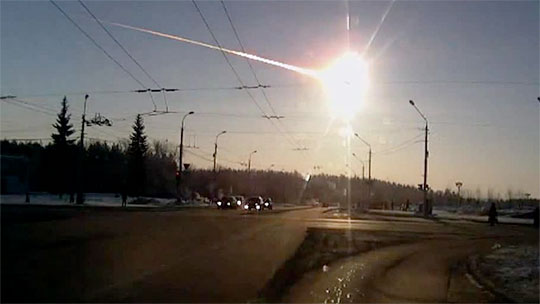Damn Close

(The Chelyabinsk meteor as it detonates above the Russian city in February of 2013).
Early this morning, an asteroid with the colorful designation of “2012 TC4” passed the earth close enough to endanger the constellation of geostationary satellites on which we depend for communications, both civil and military. If you are keeping track, the asteroid passed at about 27,300 miles above Earth, one eighth of the distance to the moon. That is close, and closer still to the geostationary satellites, which are positioned at around 22,400 miles to maintain their relative positions above the planet.
This space rock is the size of half a football field, and hauling ass. It is now continuing its hurtle toward the sun with a slight bend in trajectory caused by the Earth’s gravity. That will affect the next pass, which could be coming in as little as five years.
It first flitted past our planet in October of 2012 (hence the naming convention) at about double the distance to Earth of this visit before disappearing into the vastness of the inner solar system.
I don’t like the way this is working out, and we need to pay attention to what is coming back in five years, plus all the objects we do not yet know about. That was too damn close.
NASA was on the case and at full alert to collect data. With this close approach, NASA will have the opportunity to test its network of observatories for its planetary defense system, in the event an asteroid did actually hit Earth.
This is not the Bruce Willis sci-fi movie Armageddon. It is real. A giant meteor smashed into Earth nearly 2 billion years ago and triggered explosive and long-lived volcanic eruptions. lasting as much as a million years, according to the scientists.
Other asteroid and meteor strikes have left giant craters all over Earth. One- which may have ended the Age of the Dinosaurs 66 million year ago- left a crater more than 110 miles in diameter near the Mexican town of Chicxulub. Don’t ask me to pronounce it.
But hey, if this was something that happened only a few times (relatively) in billions of years I wouldn’t be that interested, much less concerned.
But recently, we were treated to a much smaller but still quite impressive event in the skies over Russia’s Ural Mountains. The Chelyabinsk meteor explosion was caused by an approximately 65-foot near-Earth asteroid that entered Earth’s atmosphere on 15 February 2013. It exploded about 17 miles above the city for which it is named. Windows were shattered by the force of the blast and more than 1,200 people were injured by falling debris, shock waves and exposure to the flash, although mercifully no one was seriously injured.
I was gratified that NASA has started to look back into space after spending the last few years working on vital topics like outreach to religious groups and climate research on earth. The space agency has announced that it has formalized an ongoing program to detect and track near-Earth objects, which I think is commendable. NASA operates the Planetary Defense Coordination Office within the Planetary Science Division right here in Washington. Doing some research, I was uneasy about the information available on what we are doing to improve detection and identification of objects headed our way at 4.3 miles per second.
NASA says the “office will be responsible for supervision of all Administration-funded projects to find and characterize asteroids and comets that pass near Earth’s orbit around the sun.”
It is also supposed to take a leading role in coordinating inter-agency and intergovernmental efforts in response to any potential impact threats.
Forgive me for flinching when I hear the word “inter-agency.” Here in The Swamp, that means turf and budget fights between bureaucrats and Departments, including Defense, and general inefficiency.
I think this asteroid thing ought to be a priority, don’t you? We need more sensors and more people looking, rather than spending trillions on attempting to ameliorate inflated crises that we probably will survive just fine.
If 2012 TC4 returns to smack us next time, it is essential that we have warning and enough time to get Bruce Willis suited up to save us.
Copyright 2017 Vic Socotra
www.vicsocotra.com
